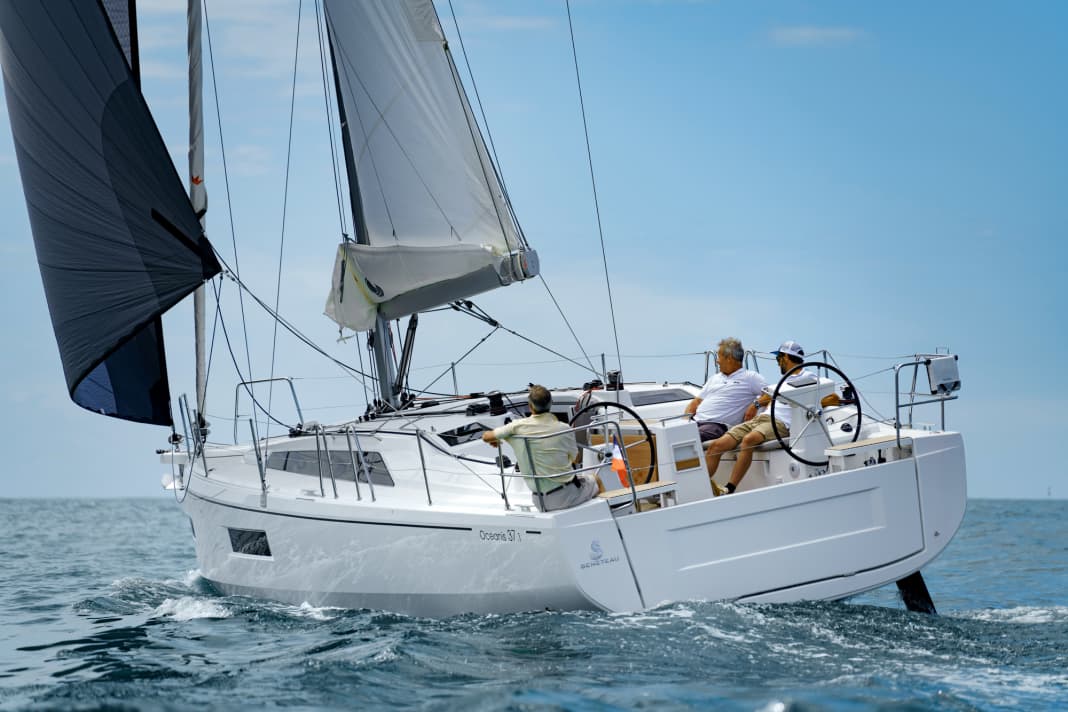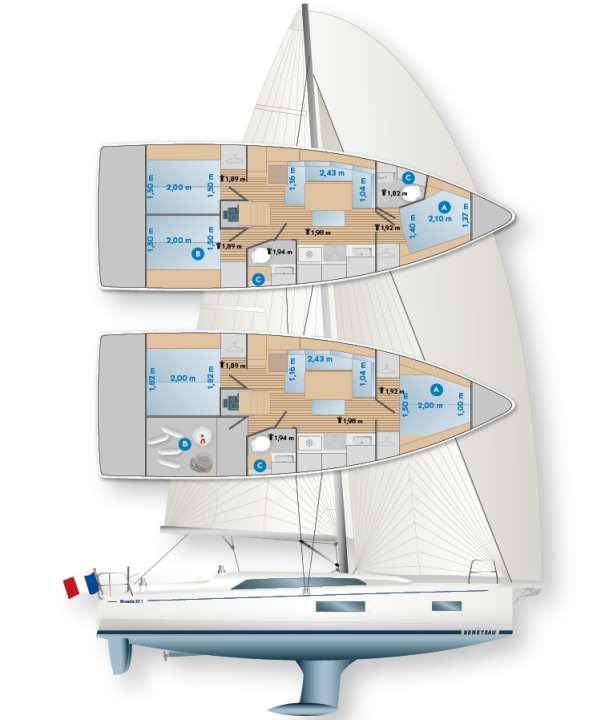Beneteau Oceanis 37.1: Test of the new edition of the French bestseller - boat premiere






Competition is known to stimulate business. This is particularly evident in the offerings of the large series manufacturers in the medium length class, i.e. cruising yachts between eleven and twelve metres in hull length. In this popular and strong-selling segment, the leading manufacturers are constantly pushing each other to new heights with ever shorter product cycles, fresh design approaches and often well thought-out detailed solutions. Only constant further developments and concept adjustments will lead to success. At the same time, it is important for companies to stick to their own brand values and maintain line loyalty. It is a difficult balancing act in a demanding and very dynamic market environment.
With a new boat for the important eleven-metre class, market leader Beneteau is currently delivering an impressive example of extremely consistent, but also innovative model development and programme maintenance. The Oceanis 37.1 is the successor to the 38.1, which has been one of the French company's bestsellers for an impressive nine years on the market. And with the new yacht, Beneteau completes the current, now ninth generation of its cruising programme.
Competition from the Beneteau Oceanis 37.1:
Marc Lombard developed the design for the Oceanis 37.1. He is now responsible for the entire Beneteau touring line between 30 and 40 feet in length - and also for the Jeanneau boats. The Sun Odyssey 380 The new Oceanis 37.1, which was launched last year, shows a striking number of visual and design parallels and can also be seen as the main competitor to the new Oceanis 37.1. This is all the more exciting as both brands, although independent, belong to the same group of companies, the all-powerful Groupe Beneteau.
The boat can do what it is supposed to do - nothing more
The typical Lombard signature is unmistakable on both boats: the slightly negative deck step, the extremely voluminous foredeck area and the deep-set chine, which runs the entire length of the boat and is set back hard in the front section for a slim waterline, are particularly characteristic. However, the two sisters also have significant differences. For example, the Jeanneau boat has the innovative walkaround cockpit for barrier-free access from the cockpit to the foredeck. On the Oceanis 37.1, the cockpit arrangement remains more conventional, but is also more spacious. In addition, the Jeanneau boat is available with a swivelling keel as an option and can fall dry. The new Beneteau boat retains the L-shaped fixed keel.
The Oceanis 37.1 scores points in comparison with its unusual layout below deck. The galley is built into the side of the saloon as a long element, which is almost a unique selling point in the length class. Only Dufour Yachts also offers the long galley unit for the 390, albeit only as an option. Meanwhile, versions with two or three double cabins and the option of adding a second wet room to the owner's area in the foredeck are standard in the class. All current competitors offer this variation for their boats in the eleven-metre class.
Pricing of the Beneteau Oceanis 37.1 not yet finalised
Of course, the pricing should also be included for comparative purposes. In the case of the Oceanis 37.1, Beneteau had only communicated the basic price by the time this issue went to press. This is €215,980 gross including 19 per cent VAT. This makes the Oceanis 37.1 slightly cheaper than its Jeanneau counterpart and only marginally more expensive than the competing boats from Bavaria and Hanse.
But beware: the price here is also for the basic version of the boat, which is only meagrely equipped and cannot really make anyone happy in this form. Although the Oceanis 37.1 is delivered with a simple set of Dacron sails, amenities such as the large stern hatch with bathing ladder, teak in the cockpit or a usable cockpit table are only available as options for a corresponding surcharge. And the basic package of the Oceanis 37.1 only has a single winch on the coachroof for all sheets, halyards and trim lines.
The strategy of omitting items is in line with a general trend that competitors sometimes also follow. Seen in this light, the basic prices within the competition remain more or less comparable. And: The buyer has more options to configure the boat according to his wishes, needs and financial circumstances, naturally for a corresponding surcharge. As the complete price list for the Oceanis 37.1 is not available for this test report, the comparative classifications of the ready-to-sail price and the comfort price according to the YACHT definition are not applicable for the time being.




The straightforward, unplayful driving standard has its advantages
The test with the prototype takes place in Les Sables-d'Olonne on the French west coast. At 10 to 12 knots and a relatively high swell, the bulky Lombard design shows good sailing characteristics when tacking. On a course of 45 degrees to the true wind, the boat logs a solid 6.4 knots on average, which is quite good for a voluminous cruising boat without any special performance requirements. And the boat also gets through the waves smoothly and without pitching. The test boat is equipped with a larger, 110 per cent overlapping genoa, which is available as an optional extra and is undoubtedly responsible for the good performance values in the test. The small self-tacking jib is standard, with which the potential remains modest with a sail load factor of 4.1.
The rig from Z Spars is new without a backstay. Instead, the spreaders are very long and also swept very strongly aft in order to achieve a mast pre-bend with a lot of rig tension and to limit the sag of the forestay. Of course, the backstay is missing as an important and efficient trimming instrument. On the other hand, the helmsman has more space if he sits to the side of the wheel, and there is no annoying wire behind him - also a good thing. And there is also the option of equipping the boat with a powerful performance mainsail with square top.
Marc Lombard's designs are known for their high dimensional stability. This is also the case with the Oceanis 37.1. The boat sails noticeably stiff and upright on all courses, even in gusts, which not least increases travelling comfort. The Oceanis reacts very lively to steering movements with the double rudder blades. However, steering downwind is no revelation. Despite the autopilot being engaged, the simple system is very smooth and has very little slippage, but also offers the helmsman no feedback due to the lack of rudder pressure. The steering therefore feels rather spongy. On boats with double rudder blades, this is often a matter of adjustment and can be corrected via the angle of attack of the fins. The steering system is easy to reach thanks to the large storage compartments in the aft peak.
Dark walnut wood is the new finishing standard
Beneteau now uses walnut veneers for the interior below deck on the new ship. The dark colours contrast well with the many light surfaces of the side and ceiling panelling. This creates visual depth and a pleasant, cosy living ambience. Woods with lighter colour tones (Nordic Oak) are still available as an option.
The standard is the two-cabin version with an aft cabin that extends far over the centre of the ship. The double berth is rectangular and, with a length of two metres, over 1.80 metres wide throughout, a level of comfort that only the competitor Sun Odyssey 380, with similarly generous dimensions, can match in this class. In the two-cabin model, the aft cabin on the starboard side is then available as a huge forecastle, which is accessible both from the cockpit and through a door from the inside. It is also possible to extend the aft wet room to include a spacious and completely separate shower room.
The galley as a long row in the saloon offers more storage space than on competitor boats, where the galleys are usually arranged more compactly to the side of the companionway. There are also plenty of work surfaces, even if there is no cover over the hob.
The quality and design of the interior fittings essentially correspond to the usual solid mass production standard. There are no particularly positive or negative surprises. The only annoying thing is that the floorboards on the prototype creak, as on many other boats. The shipyard intends to correct this in future with spacers. More handrails should also be installed for the series. These were still missing on the test boat.
With the new Oceanis 37.1, market leader Beneteau delivers a simple, but all-round solid and coherent cruising package. The competition in this popular class is current and strong, and the offers are comparable. It remains to be seen who will be the new class leader. For the Oceanis 37.1, the chances are not bad.
YACHT rating
Voluminous cruising boat from Beneteau with a high brand identity. The handling is easy, the sailing characteristics are good. The standard of equipment ex shipyard is modest.
Design and concept
- + Consistent line expansion
- + Pantry as a long row at the side
- - No variable draughts
- - Reduced basic equipment
Sailing performance and trim
- + Sails stiffly on the wind
- + Good performance potential
- + Simple handling
- - No backstay
Living and finishing quality
- + Pleasant living ambience
- + Spacious berth dimensions
- + Plenty of storage space
- + Good ventilation options
Equipment and technology
- + Electric motor as an option
- + Smooth-running controls
- - Bathing platform only optional
- - Only one winch as standard

Technical data of the Beneteau Oceanis 37.1
- Design engineer:Marc Lombard Yacht Design
- CE design category:A
- Torso length:10,99 m
- Total length:11,93 m
- Waterline length:10,83 m
- Width:3,92 m
- Draught/alternative:2,10/1,63 m
- Mast height above WL:16,60 m
- Theor. torso speed:8.0 kn
- Weight:6,86 t
- Ballast/proportion: 1,8 t/26,2 %
- Mainsail:37,0 m2
- Self-tacking jib:23,0 m²
- Furling genoa 110 % (opt.):30,0 m²
- machine (Yanmar):29 kW/40 hp
- Fuel tank (rotomould):130 l
- Fresh water tank (Rotomold):330 l
- Faeces tank (Rotomold):80 l
Hull and deck construction
Hull: GRP solid laminate, laminated by hand. Deck: GRP sandwich laminate, manufactured using vacuum injection (RTM)
Equipment and prices
- Base price ex shipyard: 215.980 €
- Price ready to sail: Not yet determined
- Comfort price: Not yet determined
- Guarantee/against osmosis: 2/2 years
Included in the basic price (among other things):
Engine, sheets, sails (main and jib), lazy bag, self-tacking equipment, storage compartment for life raft, double rudder blades, tube kicker, jumping cleats, cooler compartment (160 litres), pressurised water system, cockpit shower, hot water boiler
Rig and sail
A furling mast is also available as an alternative to the conventional standard rig. For more performance potential, the boat can be equipped with an overlapping genoa (110%) or a performance mainsail with square top
Electric motor optional
The built-in diesel engine from Yanmar with 40 hp is standard. An electric pod motor from Torqeedo with 12 kW power is also available on request
Electricity on board
Two AGM batteries are installed ex shipyard. 95 Ah for on-board power, 50 Ah as starter battery for the diesel
Shipyard
Chantiers Beneteau, 85805 Saint-Gilles-Croix-de-Vie (France), www.beneteau.com
Distribution
Dealer network

